It is generally known that all fish live and move with the cranial-caudal axis kept in a horizontal position, but there is an exception: seahorses, which live in a vertical position. Their adaptation process must have been long and complex, involving the loss of the caudal and ventral fins, scales, teeth, and opercular bones that cover the gills. Furthermore, the musculature was reduced, the head bent downwards at 90° with the rest of the body, now covered by a bony armour made up of seven thoracic rings and four caudal rings, reinforced by dorsal and lateral shields connected to the vertebrae, strengthening the entire structure.
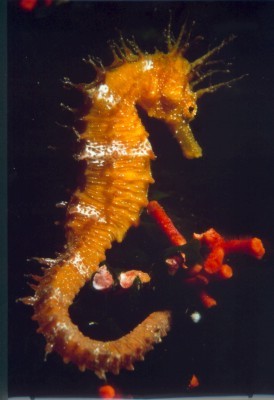
Photo by Marco Busdraghi – CC BY 3.0 via Wikimedia Common
The position and shape of the head and the long tubular snout make them resemble a chess knight, a fact accentuated by a sort of mane formed by excrescences and skin papillae, present in at least some species. This is striking if we think of the archetype of a fish, such as a trout…
The bony armour prevents a “fish-like” motility, and so seahorses have to make do with short-range movements and simple changes in depth. The relative propulsive thrust is given by the dorsal fin (now posterior) and the pectoral fins, positioned almost as if they were ears, moved curiously like small fans. Not infrequently, seahorses, attached to a tuft of algae with their tail typically curved in a spiral, allow themselves to be carried by the currents in passive dispersal movements. The erect posture is determined by the upward thrust provided by the swim bladder, compensated by the caudal part that functions as a “gravitational body” downwards. Likewise, the various positions in the water column are caused by rapid movements of gas from the anterior to the posterior part of the swim bladder.
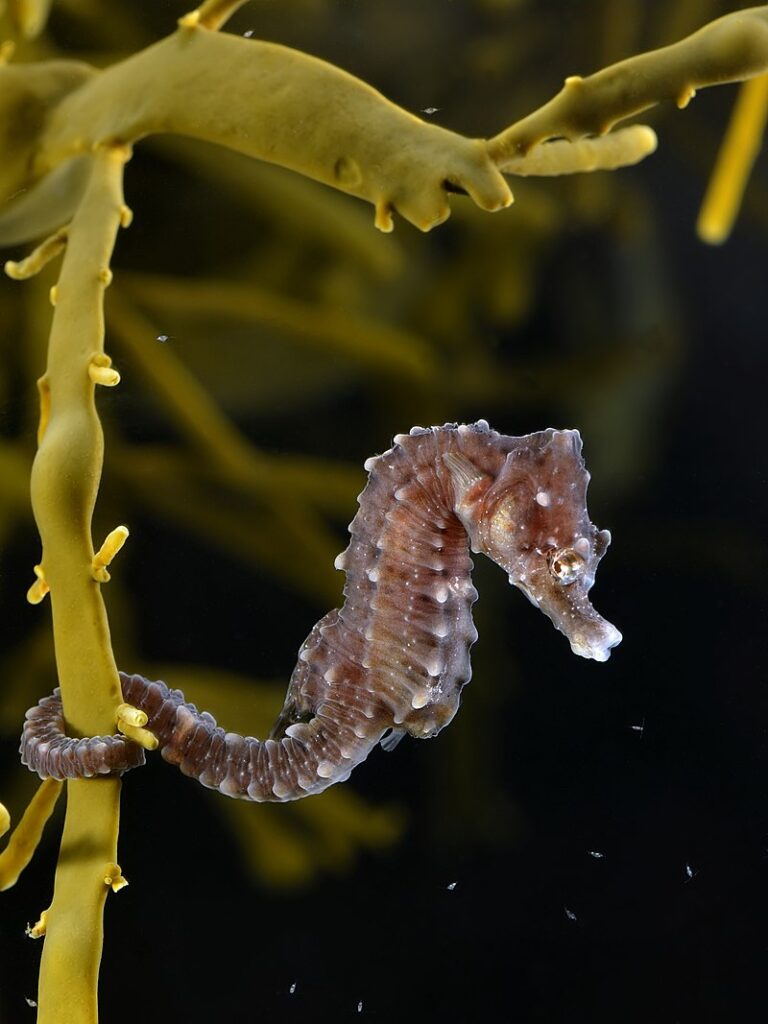
Photo by Hans Hillewaert CC BY – SA 4.0
Seahorses’ habitats are Posidonia meadows and seaweed beds at a sea depth of no more than ten meters. Skillfully hidden and camouflaged, solidly anchored with their tails, they scan the surroundings with their small eyes, which can move independently in different directions (like chameleons), waiting for small crustaceans and larvae carried by the water, to be skillfully “inhaled”. The long snout with the mouth at the tip works like a suction pipette that sucks in the prey; the flow is created by the retraction of the hyoid arch with the simultaneous lowering of the jaw that widens the oral cavity. In predation, the head represents the most mobile part, orienting itself towards the target; this too is an exclusive adaptation among fish, which have the head completely integral with the spine. It looks like seahorses have a neck!
But if the morphological adaptations in the seahorse are multiple and surprising, they are nothing compared to the reproductive ones. In the fish world, parental care is often the exclusive responsibility of the males, as in some Tilapia (Cichlid fish), in which the eggs are incubated by the males. They keep them in the oral cavity until the hatchlings emerge, which return there in case of danger, almost as if it were a safe den. No less important, the small Stickleback builds its own nest, attracts several females there by inducing them to leave their eggs there, which it then incubates until they hatch, ventilating them with its pectoral fins in order to ensure they have the necessary oxygen supply. The male’s commitment to reproduction is a common characteristic of the entire systematic group (Singnatiformes) which includes Pipefish and Seahorses. Both have developed an incubator pouch (marsupium) located after the anal opening, in the form of a skin fold with a small opening, which can be closed by a muscular sphincter. It is here that the female, at the end of a long and complex courtship ceremony, inserts the eggs with her genital papilla, leaving them in the care of the male. The eggs will develop in about four weeks inside the pouch, and the father will give birth to tiny seahorses that are very similar to their parents. He releases them in groups of 15-20 at a time, with labour lasting many hours. The birth is announced by movements of the tail brought forcefully forward so as to compress the now very tense pouch, facilitating the exit of the young. All accompanied by short sprints and leaps forward. The offspring is therefore “fit” like chicks, ready to feed themselves independently. According to some authors, the young can return to the pouch, but others deny this, something I fully agree with, given the constitution of the pouch and the limited maneuverability of the young. In the video, you can observe the birth of the seahorse Hippocampus guttulatus, a species present in the Mediterranean and the Atlantic, easily recognizable by its mane, which is missing in the typical seahorse.
Among the various descriptions of the amorous preliminaries of the Mediterranean or snub-nosed seahorse (Hippocampus antiquorum), I refer to that of W. Luther (1961). From the end of May to the beginning of July, the males, now in spawning phase, wander along the bottom with their heads lowered on their chests and their tails hanging low; the pouch is already swollen due to the high oxygen content, and they often compress it with their tails. If they encounter a mature female, she invites them to rise to the surface with repeated nods of her head, which rises and lowers several times. The two rise by turning around in a sort of carousel, facing each other and moving away again until they are belly to belly: it is then that the female protrudes her genital papilla by a few millimetres, inserting it into the opening of her marsupium. The manoeuvre is extremely rapid, about 10 seconds, during which up to 200 eggs are transferred. Thus united, with their heads turned toward each other, as if looking at each other, their tails curved back in an arc, they consummate their fleeting relationship, and everything ends. A problem: but when are the eggs fertilized? No one says (and perhaps no one knows). By analogy with what is known for some pipefish, fertilization should occur after the eggs are in the marsupium, internal fertilization of the female having never been described.
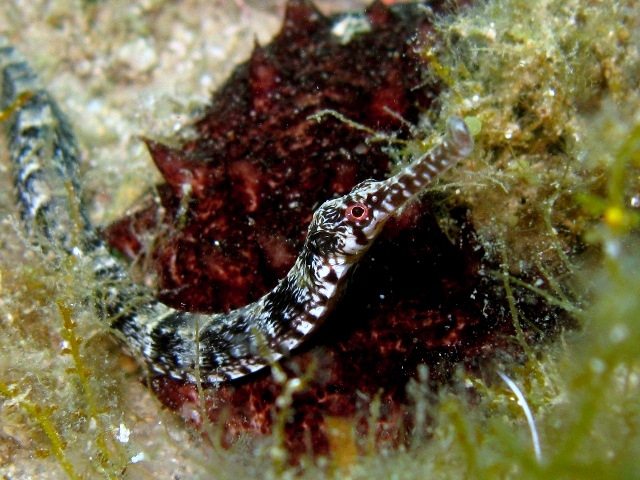
Seahorses and pipefish are widely present in all seas, even the coldest; the adaptive radiation that generated them has produced a complex of 340 species belonging to 53 different genera. The most marked changes are in seahorses, as pipefish still have a caudal fin, a less ossified armor, and swim horizontally like fish, even with undulations of the body. Some of them (Nerophytes) do not have an incubation pouch but 2-4 ventral skin folds where the female lays her eggs.
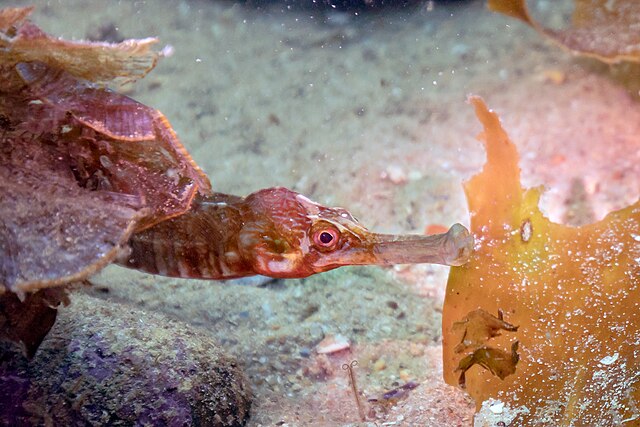
Photo by Diego Delso – CC BY SA 4.0
The expanses of algae and posidonia are the preferred habitat for all of them: it is there that they can hide and camouflage themselves with extreme effectiveness. At the same time, it is there that they can find the tiny prey that both adults and especially the young need.
The two Mediterranean species (Hippocampus antiquorum and H. guttulatus) are very similar to each other and live in the same environments, however the possibility of unwanted crossbreeding between the two is prevented by an “ethological barrier” that effectively separates them: during courtship the guttulatus twine their tails around the female’s, something that never happens in the antiquorum: evolutionary refinements for a stable coexistence!
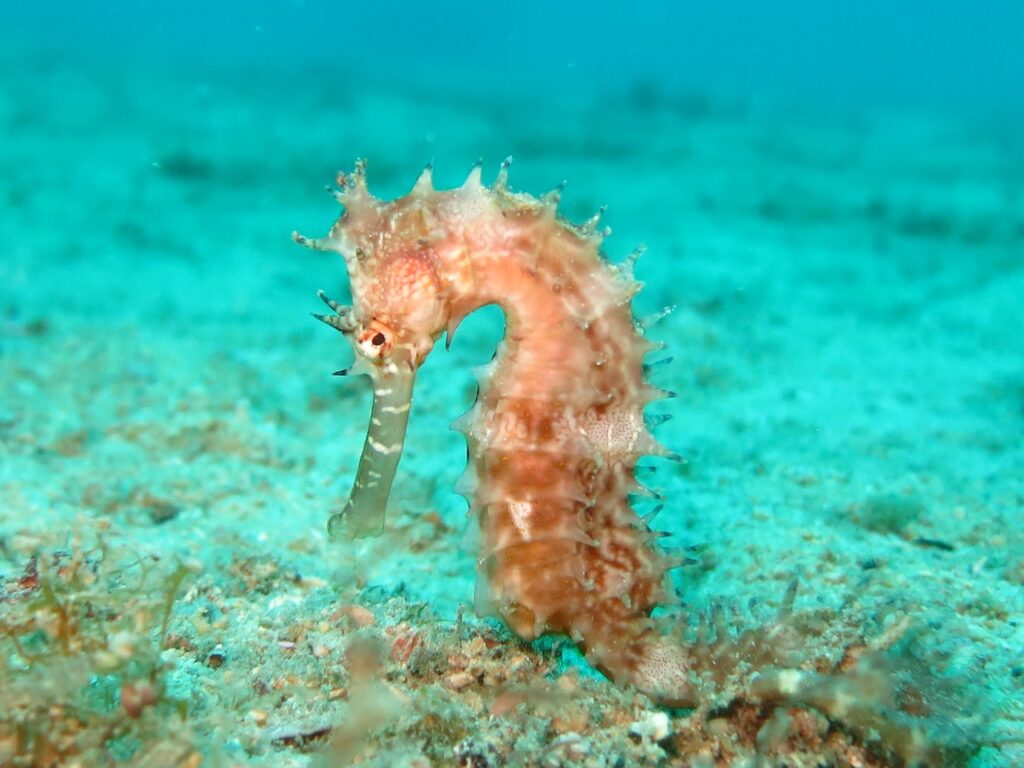
Credits
Author: N. Emilio Baldaccini Former Professor of Ethology and Conservation of Zoocenotic Resources at the University of Pisa. He has published over 300 scientific papers in national and international journals. Actively engaged in scientific education, he is also a co-author of academic textbooks on Ethology, General and Systematic Zoology, and Comparative Anatomy.
Translated by Maria Antonietta Sessa




